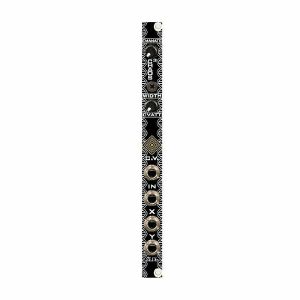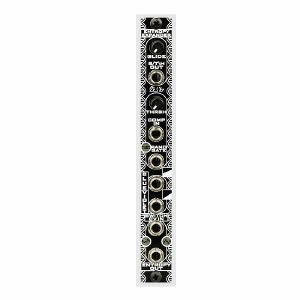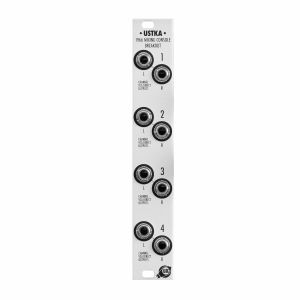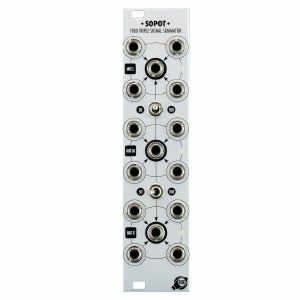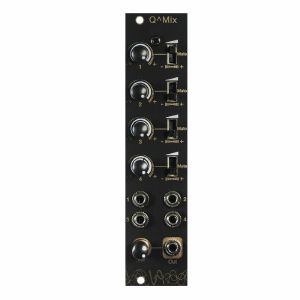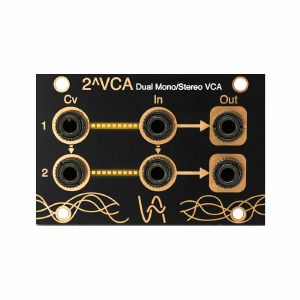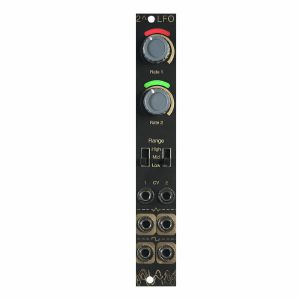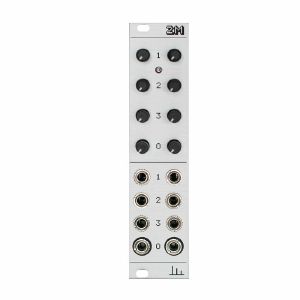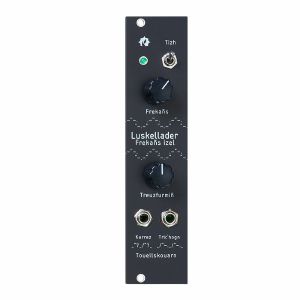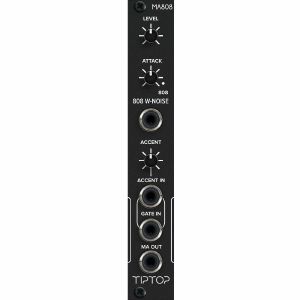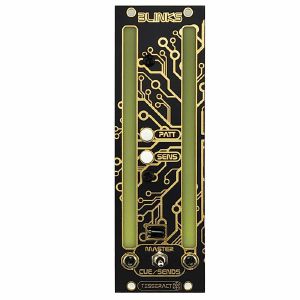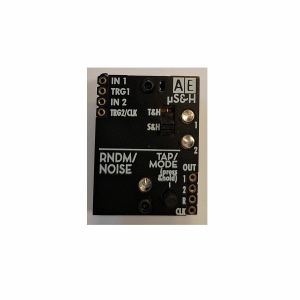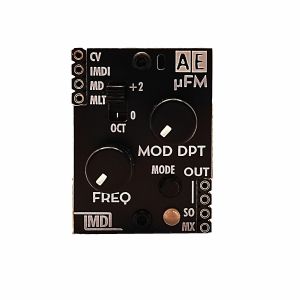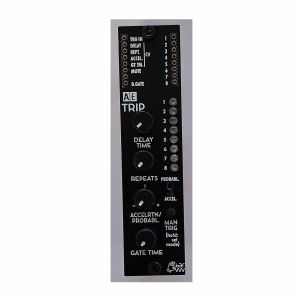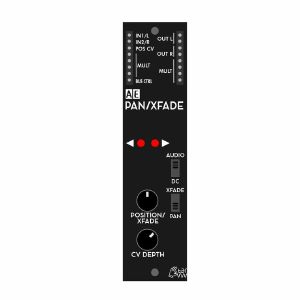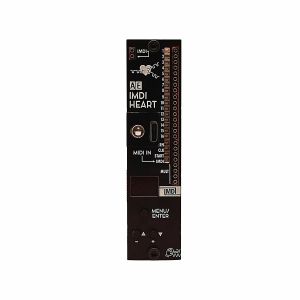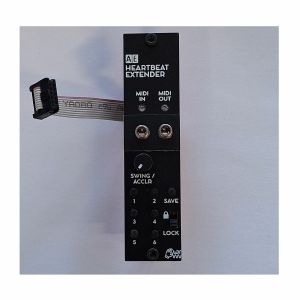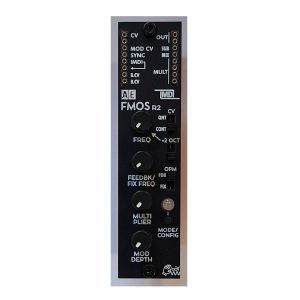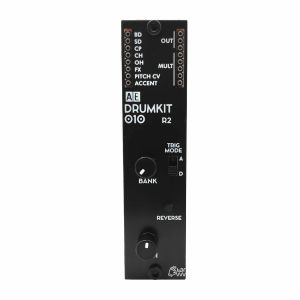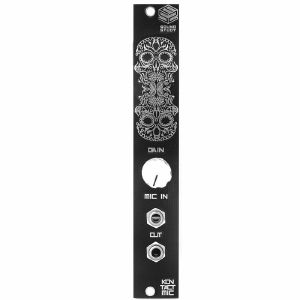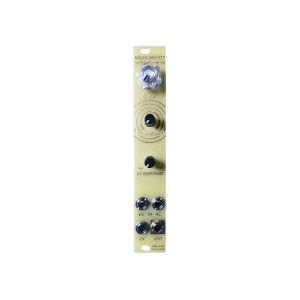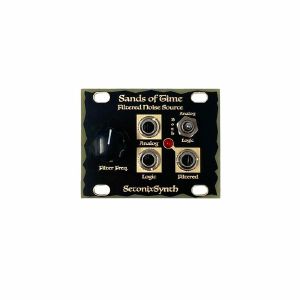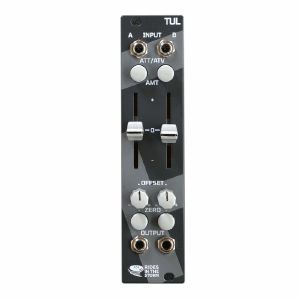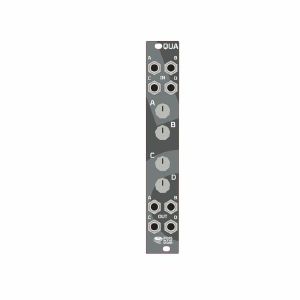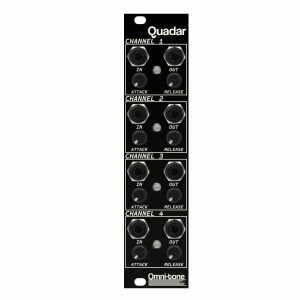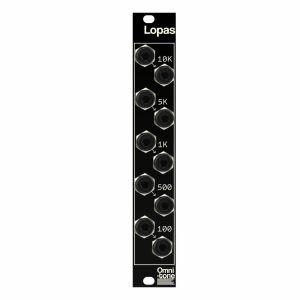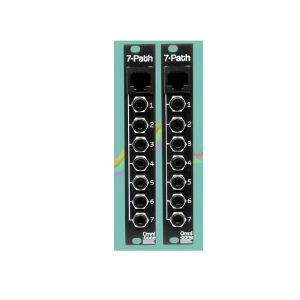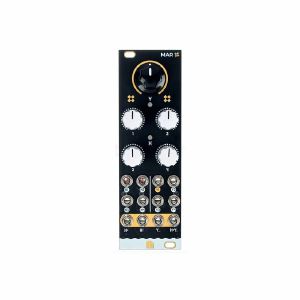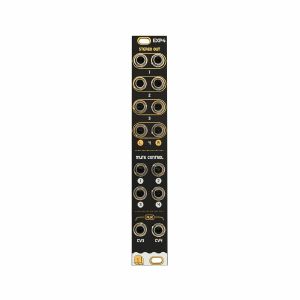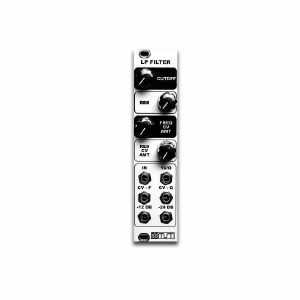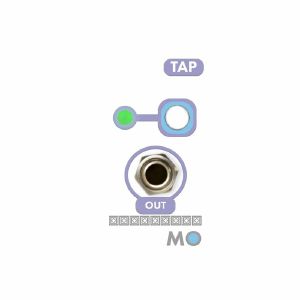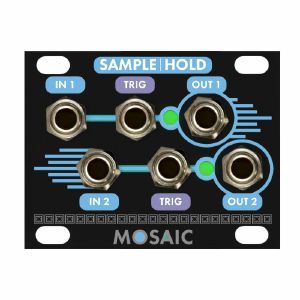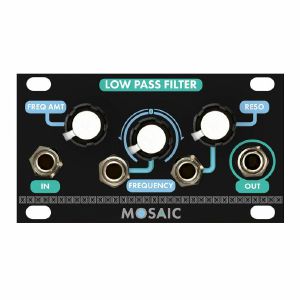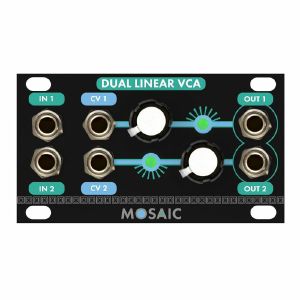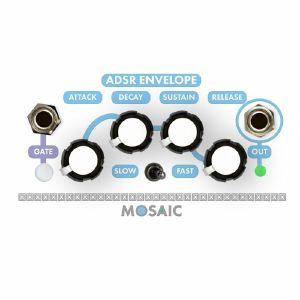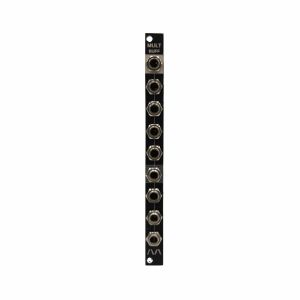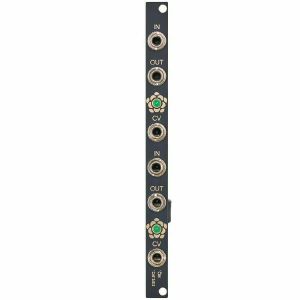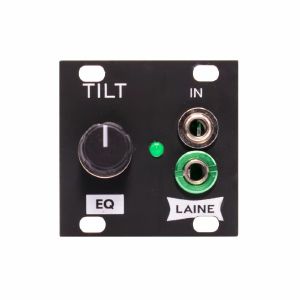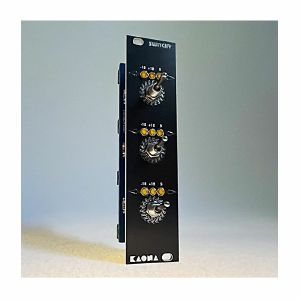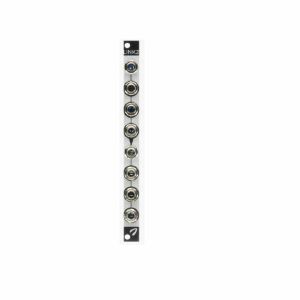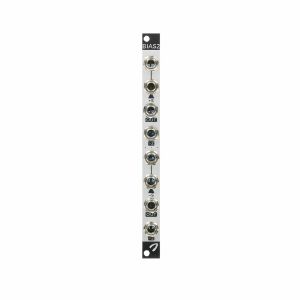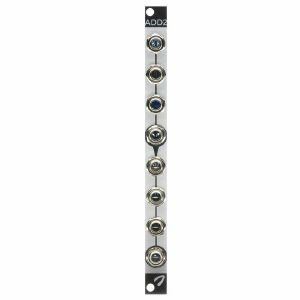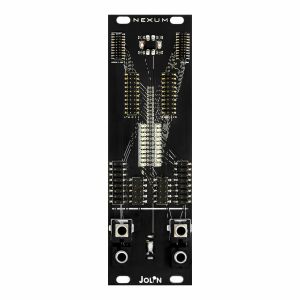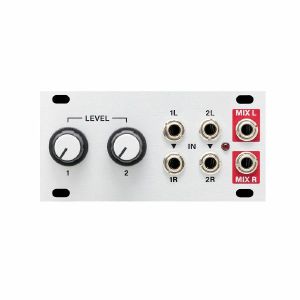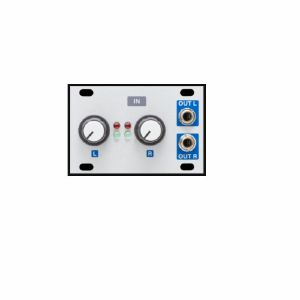Filter
シンセ・モジュール
The Eurorack modular synth format is one of the most exciting areas of music technology. Pioneered by Doepfer, there are now hundreds of brands offering compatible modules of all varieties. You can combine your choice of the best oscillators, filters and much more in order to create a unique, bespoke synth setup which perfectly suits your needs.
Eurorack modules offer the biggest range of options you can imagine, from basic analogue modules which replicate the sound of classic vintage synths, through to digital modules which allow you to explore completely new approaches to making music.
Whether you’re a beginner or a more experienced modular head, you can take your pick of the best modules from leading brands including Mutable Instruments and ALM Busy Circuits.
Our range also includes accessories, cases, patch cables and much more, allowing you to build and customise your perfect modular synth setup.

Zlob Modular Triple Cap Chaos Chaotic Oscillator & Audio Mangler Module (chaotic oscillator & audio mangler synth module)
Cat: 793149 Rel: 10 Nov 20
Analogue noise oscillator/audio mangler module
Notes: The Triple Cap Chaos(C^3 Chaos) is a 2hp analog, chaos based, noise oscillator, pseudo ring modulator/harmonics generator, and audio mangler Eurorack module available as a DIY Eurorack kit, PCB and Panel, or built.
It is a unique module, like the Diode Chaos, because it has never existed as a musical instrument until now. There is also no other module to my knowledge that can do exactly what the Triple Cap can do. The circuit(with several modifications) is based on the paper "Simple Autonomous Chaotic Circuits" by J.C. Sprott and Jessica R. Piper. As opposed to the Diode Chaos that generates control voltage this module focuses on the audio rate.
The "Emanate" potentiometer controls the coarser overall spectrum of the chaos, from lots of activity counter clock wise up to less chaos and more of a steady oscillation. The "Width, CV ATT" potentiometer can be thought of as more of a fine control for the chaos/oscillator. When something is inserted into the "CV" in the voltage normalization from the width knob is broken and the potentiometer now acts as an attenuator for the incoming cv. The Triple Cap is not a traditional volt per octave exponential VCO, and has a sort of narrow frequency range to exploit the chaotic behavior.
It expects a +5v to -5v max signal in to modulate the chaos. The "IN" jack is an A.C. coupled input for audio in, although cv and audio can work for both the "CV" in jack and "IN." The "IN" will interfere and interact with the onboard chaotic oscillator depending on the frequency of the input, which may take some experimentation. It can create ring mod ish sounds, to added harmonics, to almost bit crushed sounds depending on the "X" or "Y" output. The "X" output is a more windy noisy sinusoidal based output and the "Y" output is more squared off and aggressive, harsher sounding output.
Some quirks about the Triple Cap: The "X" output can offset negatively or positively a little bit depending on the pot settings, but both outputs tend to stay around 10vpp. With the "Emanate" and "Width" pots all the way up the typical frequency will be around 150hz although some will reach 200hz at this setting. With the "Emanate" pot full counter clock wise "Width" pot full clock wise the frequency will be around 250hz. It is possible to send signals into the triple cap that can bring it out of the desired range causing the oscillation to cut out.
The Triple Cap has a double sided panel. meaning one side has the classic graphics and the other is Soulless with less graphics.
… Read moreIt is a unique module, like the Diode Chaos, because it has never existed as a musical instrument until now. There is also no other module to my knowledge that can do exactly what the Triple Cap can do. The circuit(with several modifications) is based on the paper "Simple Autonomous Chaotic Circuits" by J.C. Sprott and Jessica R. Piper. As opposed to the Diode Chaos that generates control voltage this module focuses on the audio rate.
The "Emanate" potentiometer controls the coarser overall spectrum of the chaos, from lots of activity counter clock wise up to less chaos and more of a steady oscillation. The "Width, CV ATT" potentiometer can be thought of as more of a fine control for the chaos/oscillator. When something is inserted into the "CV" in the voltage normalization from the width knob is broken and the potentiometer now acts as an attenuator for the incoming cv. The Triple Cap is not a traditional volt per octave exponential VCO, and has a sort of narrow frequency range to exploit the chaotic behavior.
It expects a +5v to -5v max signal in to modulate the chaos. The "IN" jack is an A.C. coupled input for audio in, although cv and audio can work for both the "CV" in jack and "IN." The "IN" will interfere and interact with the onboard chaotic oscillator depending on the frequency of the input, which may take some experimentation. It can create ring mod ish sounds, to added harmonics, to almost bit crushed sounds depending on the "X" or "Y" output. The "X" output is a more windy noisy sinusoidal based output and the "Y" output is more squared off and aggressive, harsher sounding output.
Some quirks about the Triple Cap: The "X" output can offset negatively or positively a little bit depending on the pot settings, but both outputs tend to stay around 10vpp. With the "Emanate" and "Width" pots all the way up the typical frequency will be around 150hz although some will reach 200hz at this setting. With the "Emanate" pot full counter clock wise "Width" pot full clock wise the frequency will be around 250hz. It is possible to send signals into the triple cap that can bring it out of the desired range causing the oscillation to cut out.
The Triple Cap has a double sided panel. meaning one side has the classic graphics and the other is Soulless with less graphics.
1 in stock $77.96
Click for better price!
or call +44 20 7424 1960
quote 793149
quote 793149
Zlob Modular Entropy Expander Analogue Random Voltage & Noise Generator Module (analogue random voltage & noise generator synth module)
Cat: 793160 Rel: 10 Nov 20
expansion
Notes: The Entropy Expander is a 3hp Analog Random Voltage Generator that expands upon the features of the Entropy Euroack Module. Available as a Eurorack DIY Kit, PCB and Panel, or Built Module.
The Entropy+Expander packs together some of the most random voltage options in 6hp. It provides a controllable "Glide"(slew) out for the S/T\H, a comparator with a controllable rate("Thrsh") of random gates("Rand Gate") out with an input to compare other waveforms(Comp In, inserting a cable into here breaks the white noise normalization), and high pass filtered white noise resulting in approximate "Blue noise" (+3db/octave) and "Violet noise"(+6db/octave) outs.
The unique part of the circuit is a voltage controlled A/B switch thats normalled to the "Rand Gate" out that's switching between the S/T\H out(left Blue led window)and Infra out(right Red led window), the Glide control also effects the S/T\H coming out of the switch so you can get really random results from the "Entropy Out." Inserting a cable into "Switch CV In" breaks the random gate normalization and lets you toggle between A/B(left S/T\H out and right Infra out, indicated by the led windows) with your own gate or trigger.
There is a jumper on the pcb to select if you want glide on the s/t\h at, Entropy out, or un-slewed operation. There is also a trimmer for setting the amplitude of the incoming signal at "Comp In" which sets the frequency range of random gates. This may have to be adjusted depending on your Entropy version.
The random gate range can also be set up more as a noise oscillator by turning the pcb trim(clockwise) up or it can be set so random gates are extremely slow(trim counter clockwise) with minutes between random gates.
… Read moreThe Entropy+Expander packs together some of the most random voltage options in 6hp. It provides a controllable "Glide"(slew) out for the S/T\H, a comparator with a controllable rate("Thrsh") of random gates("Rand Gate") out with an input to compare other waveforms(Comp In, inserting a cable into here breaks the white noise normalization), and high pass filtered white noise resulting in approximate "Blue noise" (+3db/octave) and "Violet noise"(+6db/octave) outs.
The unique part of the circuit is a voltage controlled A/B switch thats normalled to the "Rand Gate" out that's switching between the S/T\H out(left Blue led window)and Infra out(right Red led window), the Glide control also effects the S/T\H coming out of the switch so you can get really random results from the "Entropy Out." Inserting a cable into "Switch CV In" breaks the random gate normalization and lets you toggle between A/B(left S/T\H out and right Infra out, indicated by the led windows) with your own gate or trigger.
There is a jumper on the pcb to select if you want glide on the s/t\h at, Entropy out, or un-slewed operation. There is also a trimmer for setting the amplitude of the incoming signal at "Comp In" which sets the frequency range of random gates. This may have to be adjusted depending on your Entropy version.
The random gate range can also be set up more as a noise oscillator by turning the pcb trim(clockwise) up or it can be set so random gates are extremely slow(trim counter clockwise) with minutes between random gates.
1 in stock $83.82
Click for better price!
or call +44 20 7424 1960
quote 793160
quote 793160
Zlob Modular Dual VCA Dual Summed Voltage Controlled Amplifier Module (dual summed voltage controlled amplifier synth module)
Cat: 793170 Rel: 10 Nov 20
2-channel Voltage controlled amplifier/mixer module
Notes: The Dual VCA is a 2hp 2 channel Analog VCA and Mixer Eurorack Module available as a Eurorack DIY Kit, PCB and Panel, or Built Module.
It is a DC coupled OTA(LM13700) Dual Linear VCA based on the same fabled design of the VnIcursal VCA. The 2 VCAs are summed together so it can be used as a voltage controlled mixer at the "SUM OUT" or all 3 outs can be used separately and simultaneously. 5 volts into the CV in will provide unity gain, anything above 5 volts can clip the input.
… Read moreIt is a DC coupled OTA(LM13700) Dual Linear VCA based on the same fabled design of the VnIcursal VCA. The 2 VCAs are summed together so it can be used as a voltage controlled mixer at the "SUM OUT" or all 3 outs can be used separately and simultaneously. 5 volts into the CV in will provide unity gain, anything above 5 volts can clip the input.
1 in stock $92.44
Click for better price!
or call +44 20 7424 1960
quote 793170
quote 793170
Xaoc Devices Ustka 1966 Mixing Console Breakout Module (modular synthesiser)
Cat: 1033095 Rel: 19 Jul 24
Mixing console breakout module for Ostrawa - 4HP
Notes: Ustka ['ustka] is a simple passive expander module for the Ostrawa stereo mixing console. It offers direct access to four pairs of stereo signals before they are combined into the mixed signal at the output of Ostrawa.
Ustka's main application is interfacing with external multichannel devices like computer audio interfaces and hardware multitrack recorders.
For detailed description, please refer to the manual.
Features
Per-channel VCA direct outputs
Modular or line signal level
Technical details
Eurorack standard compliant
4hp wide, 31mm deep (including cable bracket)
Current draw: no current draw (passive device)
… Read moreUstka's main application is interfacing with external multichannel devices like computer audio interfaces and hardware multitrack recorders.
For detailed description, please refer to the manual.
Features
Per-channel VCA direct outputs
Modular or line signal level
Technical details
Eurorack standard compliant
4hp wide, 31mm deep (including cable bracket)
Current draw: no current draw (passive device)
1 in stock $69.05
Click for better price!
or call +44 20 7424 1960
quote 1033095
quote 1033095
Xaoc Devices Sopot 1980 Triple Signal Summator Module (sound processor synth module)
Cat: 886632 Rel: 20 Jul 22
1980 Triple Signal Summator
Notes: Sopot is a compact utility module handy when the need arises to sum multiple stereo and mono sound sources (up to four signals for each section). It is a triple summing mixer featuring three signal adding sections with the middle one optionally fed to the top and bottom ones. The contribution of the middle section is switchable between 0%, 50%, and 100%. Each of the summing sections is built with high quality audio opamps and features a soft clipping circuit for nice saturation. Gain can be optionally reduced to -12dB in order to allow summing of hot signals.
Dimensions
6 HP
30 mm deep
Current Draw
30 mA +12V
20 mA -12V
… Read moreDimensions
6 HP
30 mm deep
Current Draw
30 mA +12V
20 mA -12V
1 in stock $91.33
Click for better price!
or call +44 20 7424 1960
quote 886632
quote 886632
VoicAs Q Mix 4-Channels CV/Audio Polarising Mixer Module (mixer synth module)
Cat: 948252 Rel: 22 Apr 25
Four channels CV/Audio polarising mixer module in 6HP.
Notes:
Q^Mix
4 channels CV/Audio polarising mixer
Q^Mix is a four-channel CV and audio mixer designed to take simple signals and combine them into something altogether new.
The four DC-coupled inputs feature a switch that selects between linear attenuation or bi-polar attenuversion.
Q^Mix can be used to sum simple signals to create much more complex results.
perfect for use as a final volume control when used as an audio mixer.
Technical Specifications
All inputs are DC-coupled.
Four-channel audio and CV mixer.
Logarithmic attenuation on the output stage.
Input impedance: 100k for all inputs.
Noise filtering and resettable fuses on the module's power input.
Reverse current protection.
Dimensions
Width
: 6HP
Depth
: 10mm
Current Draw
+12V
: 5mA
-12V
: 5mA
… Read moreQ^Mix
4 channels CV/Audio polarising mixer
Q^Mix is a four-channel CV and audio mixer designed to take simple signals and combine them into something altogether new.
The four DC-coupled inputs feature a switch that selects between linear attenuation or bi-polar attenuversion.
Q^Mix can be used to sum simple signals to create much more complex results.
perfect for use as a final volume control when used as an audio mixer.
Technical Specifications
All inputs are DC-coupled.
Four-channel audio and CV mixer.
Logarithmic attenuation on the output stage.
Input impedance: 100k for all inputs.
Noise filtering and resettable fuses on the module's power input.
Reverse current protection.
Dimensions
Width
: 6HP
Depth
: 10mm
Current Draw
+12V
: 5mA
-12V
: 5mA
1 in stock $65.72
Click for better price!
or call +44 20 7424 1960
quote 948252
quote 948252
VoicAs 2^VCA 1U Dual Mono/Stereo VCA Module (VCA synth module)
Cat: 948256 Rel: 22 Apr 25
1U dual VCA module in 12HP.
Notes: 2^VCA is a dual vca module in 1u Intellijel format.
Both of the VCA's are normlised so it can be used a stereo VCA, as a dual mono VCA , mono to stereo VCA and many more combinations.
Technical Specifications
1u Intellijel format
Noise filtering and resettable fuses on the module's power input.
Reverse current protection.
Dimensions
Width
: 12HP
Depth
: 20mm
Current Draw
+12V
: 10mA
-12V
: 10mA
… Read moreBoth of the VCA's are normlised so it can be used a stereo VCA, as a dual mono VCA , mono to stereo VCA and many more combinations.
Technical Specifications
1u Intellijel format
Noise filtering and resettable fuses on the module's power input.
Reverse current protection.
Dimensions
Width
: 12HP
Depth
: 20mm
Current Draw
+12V
: 10mA
-12V
: 10mA
1 in stock $60.71
Click for better price!
or call +44 20 7424 1960
quote 948256
quote 948256
VoicAs 2^LFO Dual Analogue VC-LFO Module (LFO synth module)
Cat: 948263 Rel: 22 Apr 25
Dual analogue voltage controller low frequency oscillator module in 4HP.
Notes:
2^LFO
Dual Analog VC-LFO
2^LFO is a dual analog VC-LFO Eurorack module, each LFO unit consists of two outputs of square and triangle that can be used simultaneously.
From LFO to Audio-Rate
Three variable rates range from super slow modulation of 20 seconds to super fast audio-rate of 700hz.
Control the speed
CV input for external control of the modulation rate.
No light bleed
Custom made light bleed blocker to prevent indicator light to bleed to other modules.
Reverse polarity protection
The module have proper reverse current and over current protection in its power input stage to protect the module in case it was connected the wrong way or connected to a faulty power supply.
Dimensions
Width
: 4HP
Depth
: 10mm
Current Draw
+12V
: 10mA
-12V
: 10mA
… Read more2^LFO
Dual Analog VC-LFO
2^LFO is a dual analog VC-LFO Eurorack module, each LFO unit consists of two outputs of square and triangle that can be used simultaneously.
From LFO to Audio-Rate
Three variable rates range from super slow modulation of 20 seconds to super fast audio-rate of 700hz.
Control the speed
CV input for external control of the modulation rate.
No light bleed
Custom made light bleed blocker to prevent indicator light to bleed to other modules.
Reverse polarity protection
The module have proper reverse current and over current protection in its power input stage to protect the module in case it was connected the wrong way or connected to a faulty power supply.
Dimensions
Width
: 4HP
Depth
: 10mm
Current Draw
+12V
: 10mA
-12V
: 10mA
1 in stock $70.45
Click for better price!
or call +44 20 7424 1960
quote 948263
quote 948263
Transient Modules 2M Dual Three Channel Mixer Module (white) (dual & stereo/mixer synth module)
Cat: 804245 Rel: 03 Jun 21
Dual three-channel mixer
Notes: The 2M is a dual three channel mixer in 6 HP with volume controls over all the inputs as well as the final output. As its design has been specially focused on audio applications, the input potentiometers are audio-taper type while the output ones are linear. Low distortion / high quality audio operational amplifiers have been selected in order to achieve clean audio mixing, but is also DC-coupled, so it can perform CV signal mixing as well. Great for a small system, allowing for submixes or even stereo mixing.
Technical specifications:
6HP.
38 mm depth.
Consumption: +/-12V 20mA
… Read moreTechnical specifications:
6HP.
38 mm depth.
Consumption: +/-12V 20mA
1 in stock $91.33
TouellSkouarn Luskellader Frekans Izel Low Frequency Oscillator Module (LFO synth module)
Cat: 950775 Rel: 19 Jun 23
Low frequency oscillator (LFO) module - 6HP.
Notes: The "Luskellader Frekans Izel" is a Low Frequency Oscillator (LFO) that can be used to modulate various parameters of the synthesizer, including pitch, filter cutoff, and amplitude. The module has 2 ouputs, with continuous morphing shapes available at the same time, one Square/PWM, one Saw/triangle/inverted saw. The LFO has a speed switch going from low to audio rates. The 2 knobs are : Speed and Morph. The module is 6HP wide and is made with quality components such as Nichicon/Panasonic caps and alpha pots.
HP : 6
… Read moreHP : 6
1 in stock $91.33
TipTop Audio MA808 TR-808 Maracas Generator Module (black) (drum synth module)
Cat: 1046469 Rel: 15 Oct 24
Maracas generator module - 4HP
Notes: The MA808 is a Eurorack module that recreates the TR-808's analogue Maracas drum voice and white noise generator at a low cost, expanding your Tiptop Audio modular drum machine. It features a fluffy, harmonically rich sound that enhances Hi-Hats dynamics. The Attack control knob allows adjustments from sharp Hi-Hat to slow-rise Maracas, with a marker for the original 808 setting.
The MA808 also includes the 808's continuous analogue white noise generator, ideal for creating custom drum sounds or general white noise use. It faithfully reproduces the original 1980s circuit and includes a high-powered gain stage for hot, distortable signals. The dual input pulse-shaper ensures stable triggering from various pulse sources, making the MA808 an easy and powerful addition to any modular synth setup.
TR-808 is a Trademark of Roland Corp Japan
Size: 4HP
Depth: 14mm
Power: +12V 16ma / -12V 14ma
… Read moreThe MA808 also includes the 808's continuous analogue white noise generator, ideal for creating custom drum sounds or general white noise use. It faithfully reproduces the original 1980s circuit and includes a high-powered gain stage for hot, distortable signals. The dual input pulse-shaper ensures stable triggering from various pulse sources, making the MA808 an easy and powerful addition to any modular synth setup.
TR-808 is a Trademark of Roland Corp Japan
Size: 4HP
Depth: 14mm
Power: +12V 16ma / -12V 14ma
1 in stock $98.01
Click for better price!
or call +44 20 7424 1960
quote 1046469
quote 1046469
Tesseract Modular Blinks VU Meter Module (utility synth module)
Cat: 797275 Rel: 07 Dec 20
Synth module
Notes: VU meter for eurorack.
BLINKS is a VU meter for eurorack with 24 RGB leds per channel, function is pretty easy, it has 2 inputs, one for each led column (no output).
PATT button changes the led pattern ( 6 patterns to choose ).
SENS button changes the input sensitivity, cycling in 7 steps.
Long pressing the PATT button enters the color scheme selection.
Long pressing SENS button enters the brightness adjustment. Most probably you'll prefer the lowest setting.
The module has a 5v regulator in case you don't have 5v in you eurorack PSU. A jumper in the back select if the led board would be powered by the 5v rail or the internal regulator (which works with the +12v rail)
Up to 3 stereo signals can be connected to a buffered input using the rear headers.
Easy DIY with only a few components, the led board is already assembled.
5v not indispensable
+5v: 30 mA (on lowest brightness)
+12v: 4mA (or ~40mA if 5v rail is not used)
… Read moreBLINKS is a VU meter for eurorack with 24 RGB leds per channel, function is pretty easy, it has 2 inputs, one for each led column (no output).
PATT button changes the led pattern ( 6 patterns to choose ).
SENS button changes the input sensitivity, cycling in 7 steps.
Long pressing the PATT button enters the color scheme selection.
Long pressing SENS button enters the brightness adjustment. Most probably you'll prefer the lowest setting.
The module has a 5v regulator in case you don't have 5v in you eurorack PSU. A jumper in the back select if the led board would be powered by the 5v rail or the internal regulator (which works with the +12v rail)
Up to 3 stereo signals can be connected to a buffered input using the rear headers.
Easy DIY with only a few components, the led board is already assembled.
5v not indispensable
+5v: 30 mA (on lowest brightness)
+12v: 4mA (or ~40mA if 5v rail is not used)
1 in stock $66.55
Click for better price!
or call +44 20 7424 1960
quote 797275
quote 797275
Tangible Waves AE Modular uS&H/RANDOM/NOISE Sample & Hold/Noise/ Random Pulses Generator Module (1U modular synthesiser)
Cat: 1012371 Rel: 07 Aug 24
Sample & hold, noise & random pulses generator module - 1U
Notes: The uS&H / RANDOM / NOISE module combines several functionalities for (pseudo) random control; it includes two sample & holds (one of them can be switched to track & hold) and a random/noise section. The latter can be switched between two types of random CV (stepped / smoothed), these either at an internal, tapped rate or an external clock.
Please note: These micro modules need a carrier, like the uBASE module. They cannot be mounted directly into an AE case.
… Read morePlease note: These micro modules need a carrier, like the uBASE module. They cannot be mounted directly into an AE case.
1 in stock $53.18
Click for better price!
or call +44 20 7424 1960
quote 1012371
quote 1012371
Tangible Waves AE Modular uFM Sound Generator Module (AE modular)
Cat: 1041397 Rel: 12 Nov 24
Sound generator module
Notes: The uFM is an oscillator module, that is focused on FM synthesis.
It's basically a two-operator FM synthesis, but with extended functionality: The operator waveforms can be either sine waves (classic FM), or four other different combinations of non-sinewave waveforms, that produce a much broader palette of sounds beyond the classic sinewave based FM synthesis.
The MOD DPT knob controls the modulation depth; in combination with a button press also the multiplier of the modulating operator can be defined.
Both parameters can be controlled also by CV and also via IMDI by MIDI controllers. The pitch can be controlled via 1V/octave CV or also via IMDI e.g. from a DAW
(For IMDI, see IMDI HEART for more info).
Additional to the normal audio output a suboctave output with a squarewave is provided, and a third output with the mix of the primary oscillator signal and the suboctave.
Quite a lot for such a tiny module, right?
Please note: These micro module needs a carrier, like the uBASE module. The cannot be mounted directly into an AE case.
… Read moreIt's basically a two-operator FM synthesis, but with extended functionality: The operator waveforms can be either sine waves (classic FM), or four other different combinations of non-sinewave waveforms, that produce a much broader palette of sounds beyond the classic sinewave based FM synthesis.
The MOD DPT knob controls the modulation depth; in combination with a button press also the multiplier of the modulating operator can be defined.
Both parameters can be controlled also by CV and also via IMDI by MIDI controllers. The pitch can be controlled via 1V/octave CV or also via IMDI e.g. from a DAW
(For IMDI, see IMDI HEART for more info).
Additional to the normal audio output a suboctave output with a squarewave is provided, and a third output with the mix of the primary oscillator signal and the suboctave.
Quite a lot for such a tiny module, right?
Please note: These micro module needs a carrier, like the uBASE module. The cannot be mounted directly into an AE case.
1 in stock $53.18
Click for better price!
or call +44 20 7424 1960
quote 1041397
quote 1041397
Tangible Waves AE Modular Trip Trigger Processor Module (clock generator/sequencer synth module)
Cat: 967255 Rel: 14 Feb 24
Trigger processor module.
Notes: It takes incoming triggers and repeats them - you can think of it as a delay module for triggers. The delay time and the number of repeats can be set with a knob and additionally be CV controlled. Beyond of static delay, the delays of one input trigger can be accelerated or decelerated, leading to the rhythm of a bouncing ball. In another mode, the probability of the output triggers can be chosen.
Different output modes change the assignment of the delays to the eight outputs; either, all delayed triggers for one input trigger are on one output, or the delays go through the outputs 1...8. By this, complex events can be triggered.
Finally, the acceleration and the gate time can be CV controlled as well.
The module is "polyphonic" in a sense, that consecutive triggers at the input don't stop currently running trigger outputs from a previous trigger, but mixing them all. Together with variable delay times and acceleration, highly complex trigger patterns can appear on each of the eight outputs.
… Read moreDifferent output modes change the assignment of the delays to the eight outputs; either, all delayed triggers for one input trigger are on one output, or the delays go through the outputs 1...8. By this, complex events can be triggered.
Finally, the acceleration and the gate time can be CV controlled as well.
The module is "polyphonic" in a sense, that consecutive triggers at the input don't stop currently running trigger outputs from a previous trigger, but mixing them all. Together with variable delay times and acceleration, highly complex trigger patterns can appear on each of the eight outputs.
1 in stock $60.13
Click for better price!
or call +44 20 7424 1960
quote 967255
quote 967255
Tangible Waves AE Modular PAN/XFADE Routing Processor Module (utility module)
Cat: 1010428 Rel: 16 Aug 24
Routing processor module
Notes: The PAN/XFADE module is a combined routing processor for creating panning and crossfades. The PAN/XFADE works either as a signal panner, meaning one input signal is moved continuously between the left and right output, or, in crossfade mode, where it blends between two input signals into one output. Of course controllable by CV; and working for audio signals as well as DC control voltages.
… Read more 1 in stock $60.13
Click for better price!
or call +44 20 7424 1960
quote 1010428
quote 1010428
Cat: 1041387 Rel: 12 Nov 24
Interface module
Notes: The IMDI HEART module is the central module for using IMDI (the "internal MIDI" transmision) within AE modular.
It receives MIDI, either by a TRS adapter, or via USB-C (the module appears as Class-compliant MIDI device on a computer); the incoming data is splitted up to 16 outputs carrying IMDI data. Each output contains the information of one (or more) MIDI channel(s) and a freely assignable note range, in the standard MIDI data rate or at a much higher data rate. Realtime data, like MIDI start/stop/clock is provided as gate/trigger outputs; the 1/96th clock can be divided to other, slower clock rates.
The outputs can drive then modules that can receive IMDI, like the micro oscillators (uOSC, uFM, uPOLY) and other upcoming IMDI capable modules.
The 16 chains of IMDI controlled modules you get with IMDI HEART is enough for quite complex setups, so in most cases, one IMDI HEART will be enough.
… Read moreIt receives MIDI, either by a TRS adapter, or via USB-C (the module appears as Class-compliant MIDI device on a computer); the incoming data is splitted up to 16 outputs carrying IMDI data. Each output contains the information of one (or more) MIDI channel(s) and a freely assignable note range, in the standard MIDI data rate or at a much higher data rate. Realtime data, like MIDI start/stop/clock is provided as gate/trigger outputs; the 1/96th clock can be divided to other, slower clock rates.
The outputs can drive then modules that can receive IMDI, like the micro oscillators (uOSC, uFM, uPOLY) and other upcoming IMDI capable modules.
The 16 chains of IMDI controlled modules you get with IMDI HEART is enough for quite complex setups, so in most cases, one IMDI HEART will be enough.
1 in stock $77.42
Click for better price!
or call +44 20 7424 1960
quote 1041387
quote 1041387
Tangible Waves AE Modular Heartbeat Extender Heartbeat's Expander Module (clock generator/MIDI/utility/expander synth module)
Cat: 967225 Rel: 14 Feb 24
Heartbeat's expander module.
Notes: The HEARTBEAT EXTENDER expands the functionality of the HEARTBEAT module. It is connected to the HEARTBEAT module with a small ribbon cable (included) and offers following features:
Six preset buttons to store and recall different tempos with one button press
MIDI in and out sockets with LED indicators: The HEARTBEAT module can follow incoming MIDI timing data (MIDI start/stop/clock) as an additional option; and the current tempo of the HEARTBEAT is sent out as MIDI timing data if it acts as master clock in a complete system - other MIDI devices will follow it's tempo.
A knob that controls either the swing amount or the transition time when changing from one preset to another (known as accelerando/ritardando).
A lock switch, that disable the save button and other functions that could be an issue e.g. in live situations.
… Read moreSix preset buttons to store and recall different tempos with one button press
MIDI in and out sockets with LED indicators: The HEARTBEAT module can follow incoming MIDI timing data (MIDI start/stop/clock) as an additional option; and the current tempo of the HEARTBEAT is sent out as MIDI timing data if it acts as master clock in a complete system - other MIDI devices will follow it's tempo.
A knob that controls either the swing amount or the transition time when changing from one preset to another (known as accelerando/ritardando).
A lock switch, that disable the save button and other functions that could be an issue e.g. in live situations.
1 in stock $60.13
Click for better price!
or call +44 20 7424 1960
quote 967225
quote 967225
Tangible Waves AE Modular FMOS FM Synthesis Module (oscillator synth module)
Cat: 786477 Rel: 16 Oct 20
Synthesis module
Notes: FM synthesis for the AE!
The FMOS is a new digital oscillator that brings FM synthesis to the AE modular! It offers the basic FM synthesis with one oscillator and one modulator, running both with sine waves or triangle waves. The modulation depth and frequency ratio of the modulator can be set with a knob and additionally by CV control. If you want pure sine waves, this is for you too - simply set the modulation level to 0.
The module is based on a simple 8-bit microcontroller and an adapted design of Jan Ostman.
… Read moreThe FMOS is a new digital oscillator that brings FM synthesis to the AE modular! It offers the basic FM synthesis with one oscillator and one modulator, running both with sine waves or triangle waves. The modulation depth and frequency ratio of the modulator can be set with a knob and additionally by CV control. If you want pure sine waves, this is for you too - simply set the modulation level to 0.
The module is based on a simple 8-bit microcontroller and an adapted design of Jan Ostman.
1 in stock $69.34
Click for better price!
or call +44 20 7424 1960
quote 786477
quote 786477
Tangible Waves AE Modular DRUMKIT 010 R2 8-Bit Drum Sound Generator Module (sound generation module)
Cat: 1010419 Rel: 16 Aug 24
8-bit drum sound generator module
Notes: DRUMKIT 010 consists of 11 8-bit drum sound samples; 6 of them can be triggered in parallel in any combination by the trigger inputs. With a BANK selector knob, different combinations of the 11 samples can be selected. The PITCH knob affects the pitch of all instruments together, and with the REVERSE button the sounds are played backwards - quite a nice effect to be added here and there.
By design, this is a nasty, lo-fi drum sound source, but definitely with its own character. It works great together with the analogue KICK module.
… Read moreBy design, this is a nasty, lo-fi drum sound source, but definitely with its own character. It works great together with the analogue KICK module.
1 in stock $83.52
Click for better price!
or call +44 20 7424 1960
quote 1010419
quote 1010419
SynthRotek 1U Stereo Output Mixer Module (black faceplate) (synth module)
Cat: 777888 Rel: 22 Jan 21
stereo output mixer module
Notes: The 1U Stereo Mixer is intended for pannable stereo output, but it is also suitable for both DC (Gates, Triggers and Control Voltage) & AC (audio) signals.
Specifications:
Current draw: +12: 13mA, -12: 9.2mA
Depth: 32mm
Width: 24HP
Please note: Synthrotek's 1U products do not fit in Vermona or Intellijel cases.
… Read moreSpecifications:
Current draw: +12: 13mA, -12: 9.2mA
Depth: 32mm
Width: 24HP
Please note: Synthrotek's 1U products do not fit in Vermona or Intellijel cases.
1 in stock $66.82
Sound Study Modular Kontact Mic Preamp Module (preamp synth module)
Cat: 778088 Rel: 28 May 21
mic module
Notes: The Kontact MIC is a lo-fi theme park. It's a Eurorack microphone preamp with a piezo contact mic built into the panel.
The creative applications are endless: finger percussion/rubbing/scratching, guitar input (works surprisingly well with just a little lofi crunch), acoustic sources to CV, etc.
The PCB fibreglass has quite a nice rough texture - rubbing it with a finger or a plectrum creates quite a wide range of sounds. The back of the panel is plated to expand the surface area of the contact mic. The mic will also pick up all the physical sounds in your modular- patching, cables rustling, switches, fingers on knobs - without picking up airborne sounds i.e. the sound your modular is making. At very high sound levels will pick up vibrations from the speaker output and start to feedback.
The module will work with both DIYed contact mics made from inexpensive piezo transducers, off the shelf contact mics (often called Piezo Pickups) made for guitars and violins which you can pick up for ten bucks from Amazon or eBay or more bespoke mics like the popular Jez Riley French models (including hydrophones!) which are firmly aimed at Sound Designers.
It is an easy way to bring environmental noise and feedback into a modular system, inspired by the early days of electroacoustic music in Paris and Cologne, and by the contact microphone and phonograph cartridge experiments of John Cage, Gordon Mumma, Robert Ashley and Nicholas Collins.
… Read moreThe creative applications are endless: finger percussion/rubbing/scratching, guitar input (works surprisingly well with just a little lofi crunch), acoustic sources to CV, etc.
The PCB fibreglass has quite a nice rough texture - rubbing it with a finger or a plectrum creates quite a wide range of sounds. The back of the panel is plated to expand the surface area of the contact mic. The mic will also pick up all the physical sounds in your modular- patching, cables rustling, switches, fingers on knobs - without picking up airborne sounds i.e. the sound your modular is making. At very high sound levels will pick up vibrations from the speaker output and start to feedback.
The module will work with both DIYed contact mics made from inexpensive piezo transducers, off the shelf contact mics (often called Piezo Pickups) made for guitars and violins which you can pick up for ten bucks from Amazon or eBay or more bespoke mics like the popular Jez Riley French models (including hydrophones!) which are firmly aimed at Sound Designers.
It is an easy way to bring environmental noise and feedback into a modular system, inspired by the early days of electroacoustic music in Paris and Cologne, and by the contact microphone and phonograph cartridge experiments of John Cage, Gordon Mumma, Robert Ashley and Nicholas Collins.
1 in stock $63.21
Click for better price!
or call +44 20 7424 1960
quote 778088
quote 778088
SetonixSynth/Tidbit Audio Solar Gravity Vactrol Response VCA Module (VCA synth module)
Cat: 948372 Rel: 21 Feb 25
Vactrol response voltage controlled amplifier module in 4HP.
Notes: The Solar Gravity from SetonixSynth and Tidbit Audio is an analogue vactrol-based VCA designed to bring the lovely response of optocouplers into the realm of clean, performance-based Eurorack VCAs. Starting with this simple concept, the Solar Gravity utilizes some neat active circuitry to significantly reduce the bleed inherent in vactrol-based VCAs and to provide the user with lots of control over the level, direction, and response of incoming control voltage.
Though it's primarily designed for use with audio signals, the Solar Gravity can also be used to control the level of CV such as envelopes or stepped voltages with a unique vactrol response through its DC-coupled input.
Technical Specifications
Width: 4hp
Depth: 28mm
Peak Current Draw: 16mA @ +12V, 18mA @ -12V
Input Impedance (All Inputs): 100kO
Output Impedance: 1kO
AC Input Cutoff Frequency (-3dB High Pass): 5 Hz approx.
… Read moreThough it's primarily designed for use with audio signals, the Solar Gravity can also be used to control the level of CV such as envelopes or stepped voltages with a unique vactrol response through its DC-coupled input.
Technical Specifications
Width: 4hp
Depth: 28mm
Peak Current Draw: 16mA @ +12V, 18mA @ -12V
Input Impedance (All Inputs): 100kO
Output Impedance: 1kO
AC Input Cutoff Frequency (-3dB High Pass): 5 Hz approx.
3 in stock $79.63
Click for better price!
or call +44 20 7424 1960
quote 948372
quote 948372
SetonixSynth Sands Of Time 1U Filtered Noise Source Module (noise source module)
Cat: 1062988 Rel: 21 Feb 25
A compact 1U noise source which contains two separate noise circuits
Notes: SetonixSynth Sands Of Time 1U Filtered Noise Source Module
The SetonixSynth Sands of Time is a compact 1U noise source which contains two separate noise circuits: a transistor-based analog noise generator similar to those used in many classic modular synth systems of the '60s and '70s, and a CMOS logic-based fixed oscillator bank as found in some of the great drum machines of the '80s, particularly of the TR series.
Either or both of these noise sources may be routed to a sweepable active bandpass filter, perfect for shaping the noise into many different "flavors," from low-frequency rumble, to chest-thumping midrange snare source, to hissing raw hi-hat noise and everything in between.
In a very small package, the Sands of Time provides a full palette of audio frequencies and Noise-like sounds which are useful in many popular patching techniques, especially analog drum patches and "Noise Walls" along with the generation of pseudo-random voltages for use with Sample & Holds, slew generators, and more.
Though it demands just 10hp of 1U rack space, the Sands of Time is still a useful and diverse noise source with some "oomph," a crucial yet often overlooked addition to any setup or patch.
Width: 10 hp (Intellijel 1U format)
Depth: 35 mm
Peak Current Draw: 25 mA @ +12V, 25mA @ -12V
… Read moreThe SetonixSynth Sands of Time is a compact 1U noise source which contains two separate noise circuits: a transistor-based analog noise generator similar to those used in many classic modular synth systems of the '60s and '70s, and a CMOS logic-based fixed oscillator bank as found in some of the great drum machines of the '80s, particularly of the TR series.
Either or both of these noise sources may be routed to a sweepable active bandpass filter, perfect for shaping the noise into many different "flavors," from low-frequency rumble, to chest-thumping midrange snare source, to hissing raw hi-hat noise and everything in between.
In a very small package, the Sands of Time provides a full palette of audio frequencies and Noise-like sounds which are useful in many popular patching techniques, especially analog drum patches and "Noise Walls" along with the generation of pseudo-random voltages for use with Sample & Holds, slew generators, and more.
Though it demands just 10hp of 1U rack space, the Sands of Time is still a useful and diverse noise source with some "oomph," a crucial yet often overlooked addition to any setup or patch.
Width: 10 hp (Intellijel 1U format)
Depth: 35 mm
Peak Current Draw: 25 mA @ +12V, 25mA @ -12V
1 in stock $71.84
Click for better price!
or call +44 20 7424 1960
quote 1062988
quote 1062988
Rides In The Storm TUL Dual Attenuverter & Offset Generator Module (atenuator/CV modulation synth module)
Cat: 805793 Rel: 04 Mar 21
Dual attenuverter/offset generator module
Notes: TUL Dual Attenuator/-verter and Offset Generator
Temperature stable and accurate circuit design. The attenuator is exponential and can be regulated more precisely in the initial range.
As an attenuverter, the fader describes an S-curve, i.e. it is in Range +/- 0 finer adjustable. The AC gain is 1, so there is no loss at maximum Att/Attv settings.
The offset potentiometer shift by +/- 5 volts and can be switched to another mode on the back of the PCB using jumpers.
Here the attenuation is towards zero made until it is zero.
The normal mode leaves the voltage at the specified offset value.
Channel A is normalized to channel B so you can get two different CVs.
On the rear side of the PCB, you have a jumper to switch from offset pre fader (good for ADSR) and post fader.
Power consumption: +/- 20mA
Rackspace: 6HP
CV out is (-/+5Volt) if nothing is patched to IN A/B, so you can use it as a manual CV source.
… Read moreTemperature stable and accurate circuit design. The attenuator is exponential and can be regulated more precisely in the initial range.
As an attenuverter, the fader describes an S-curve, i.e. it is in Range +/- 0 finer adjustable. The AC gain is 1, so there is no loss at maximum Att/Attv settings.
The offset potentiometer shift by +/- 5 volts and can be switched to another mode on the back of the PCB using jumpers.
Here the attenuation is towards zero made until it is zero.
The normal mode leaves the voltage at the specified offset value.
Channel A is normalized to channel B so you can get two different CVs.
On the rear side of the PCB, you have a jumper to switch from offset pre fader (good for ADSR) and post fader.
Power consumption: +/- 20mA
Rackspace: 6HP
CV out is (-/+5Volt) if nothing is patched to IN A/B, so you can use it as a manual CV source.
1 in stock $74.62
Click for better price!
or call +44 20 7424 1960
quote 805793
quote 805793
Rides In The Storm QUA Quad Attenuator & VC Generator Module (attenuator/CV modulation synth module)
Cat: 846780 Rel: 29 Dec 21
Quad attenuater
Notes: QUA Quad Attenuator
without CV In each Channel generates 0-10V
Power consumption: +/-10 mA
Rackspace: 4HP
… Read morewithout CV In each Channel generates 0-10V
Power consumption: +/-10 mA
Rackspace: 4HP
1 in stock $63.48
Click for better price!
or call +44 20 7424 1960
quote 846780
quote 846780
Omni-Tone Quadar Quad Envelope Generator Module (envelope generator synth module)
Cat: 1078405 Rel: 31 Mar 25
Quadar is an analogue 4 channel slew rate limiter that can be used as an attack/release envelope generator
Notes: Want to smooth out attack and release on your signals, but don't want to sacrifice too much space in your case?
Quadar is an analogue 4 channel slew rate limiter that can be used as an attack/release envelope generator. Send in any signal to independently control the attack time and release time with the A and R knobs.
Technical Specs:
- 3U x 6HP x 25 mm deep
- Current Draw: 10mA @ 12V, 10mA @ -12V
What's in the box:
- 1x Quadar module
- 1x Power cable
- 2x Mounting screws
… Read moreQuadar is an analogue 4 channel slew rate limiter that can be used as an attack/release envelope generator. Send in any signal to independently control the attack time and release time with the A and R knobs.
Technical Specs:
- 3U x 6HP x 25 mm deep
- Current Draw: 10mA @ 12V, 10mA @ -12V
What's in the box:
- 1x Quadar module
- 1x Power cable
- 2x Mounting screws
1 in stock $89.66
Click for better price!
or call +44 20 7424 1960
quote 1078405
quote 1078405
Omni-Tone Lopas 5x Passive Low Pass Filters Module (filter synth module)
Cat: 1078485 Rel: 31 Mar 25
Lopas is a great, compact solution for your passive filtering need
Notes: Have some noisy modules in your case? Or maybe you're just looking to attenuate your sound for a different vibe. Whatever your case, Lopas is a great, compact solution for your passive filtering needs. Lopas has 5 passive low-pass filters each with a different cutoff frequency (10k, 5k, 1k, 500, 100) at -6dB/octave. Lopas has NO resonance making it great for reducing unwanted harsh frequencies without sacrificing a VCF.
Technical specs:
3U x 4HP x 20 mm deep.
Passive Module -- No power required!
What's in the box:
1x Lopas Module
2x Mounting Screws
… Read moreTechnical specs:
3U x 4HP x 20 mm deep.
Passive Module -- No power required!
What's in the box:
1x Lopas Module
2x Mounting Screws
1 in stock $66.55
Click for better price!
or call +44 20 7424 1960
quote 1078485
quote 1078485
Omni-Tone 7Path Ethernet Patch Cable Bridge Modules (pair) (utility synth module)
Cat: 1078452 Rel: 28 Mar 25
7Path is a pair of modules that can connect two points in your system, or two different systems together via an ethernet cable
Notes: Connect Eurorack Cases without long patch cables. Great for jams and large systems.
7Path is a pair of modules that can connect two points in your system, or two different systems together via an ethernet cable. Think of it like a patch cable extension cord: instead of 7 long patch cables, you just have 1 ethernet cable! 7Path allows patching of any type of eurorack signal to be passed between the modules. There is no restriction for using only input or output signals on the modules, you can have combinations of both.
The jack numbers between the modules are 1-1. Thus, a signal you patch to the #4 jack of a 7Path module will be available on #4 jack of the other 7Path module!
Technical Specs:
- 4HP x 3U x 20mm deep
- Passive module (no power required)
- Supports signals up to 10ft (unshielded ethernet cable, more if shielded)
What's in the box:
- 2x 7Path modules
- 4x Mounting screws
Note: Does not include ethernet cable
… Read more7Path is a pair of modules that can connect two points in your system, or two different systems together via an ethernet cable. Think of it like a patch cable extension cord: instead of 7 long patch cables, you just have 1 ethernet cable! 7Path allows patching of any type of eurorack signal to be passed between the modules. There is no restriction for using only input or output signals on the modules, you can have combinations of both.
The jack numbers between the modules are 1-1. Thus, a signal you patch to the #4 jack of a 7Path module will be available on #4 jack of the other 7Path module!
Technical Specs:
- 4HP x 3U x 20mm deep
- Passive module (no power required)
- Supports signals up to 10ft (unshielded ethernet cable, more if shielded)
What's in the box:
- 2x 7Path modules
- 4x Mounting screws
Note: Does not include ethernet cable
1 in stock $68.78
Click for better price!
or call +44 20 7424 1960
quote 1078452
quote 1078452
NANO Modules MAR Multi-Channel Dual Mixer Module (mixer synth module)
Cat: 796881 Rel: 20 Nov 20
Multichannel dual mixer module
Notes: MAR is a multichannel dual mixer module for the modular synthesizer. Both mixers are capable of mixing audio, CV and gate signals because they are DC coupled. MAR has two independent 4-channels mixers:
Mixer X: Is a four channel mixer with gain control for each channel. The potentiometers use logarithmic tape to have a good control with audio signals. This mixer features two outputs, the mixer output and its inverted. The output level is shown in the LED.
Mixer Y: Is a four channel mixer with gain control for the sum of the Y channels. If no jack is connected to the input Y1, the output of the Mixer X is normalled to Mixer Y. The potentiometer use logarithmic tape to have a good control with audio signals. This mixer features one output, the sum of the 4 channels. The output level is shown in the LED.
This Mixer can work as two 4-1 Mixer, or 7-1 Mixer with global gain control.
INPUTS:
4 Mixer X inputs.
4 Mixer Y inputs.
OUTPUTS:
Mixer X output.
Inverted Mixer X output.
Mixer Y output.
Mixer X + Mixer Y output.
FAST SPECS:
Dual mixer module for the modular synthesizer - Eurorack.
8 HP - 15mm Depth - Skiff friendly.
Both mixers are capable of mixing audio, CV and gate signals.
Mixer X: 4-channel mixer with gain control for each channel.
Mixer Y: 4-channel mixer with gain control for the sum of the channels.
If no cable connected to Mixer Y input 1, the output of the Mixer X is normalled to Mixer Y.
Can work as two 4-channel mixers, or one 7-channel mixer.
The output level is shown in the LEDs.
… Read moreMixer X: Is a four channel mixer with gain control for each channel. The potentiometers use logarithmic tape to have a good control with audio signals. This mixer features two outputs, the mixer output and its inverted. The output level is shown in the LED.
Mixer Y: Is a four channel mixer with gain control for the sum of the Y channels. If no jack is connected to the input Y1, the output of the Mixer X is normalled to Mixer Y. The potentiometer use logarithmic tape to have a good control with audio signals. This mixer features one output, the sum of the 4 channels. The output level is shown in the LED.
This Mixer can work as two 4-1 Mixer, or 7-1 Mixer with global gain control.
INPUTS:
4 Mixer X inputs.
4 Mixer Y inputs.
OUTPUTS:
Mixer X output.
Inverted Mixer X output.
Mixer Y output.
Mixer X + Mixer Y output.
FAST SPECS:
Dual mixer module for the modular synthesizer - Eurorack.
8 HP - 15mm Depth - Skiff friendly.
Both mixers are capable of mixing audio, CV and gate signals.
Mixer X: 4-channel mixer with gain control for each channel.
Mixer Y: 4-channel mixer with gain control for the sum of the channels.
If no cable connected to Mixer Y input 1, the output of the Mixer X is normalled to Mixer Y.
Can work as two 4-channel mixers, or one 7-channel mixer.
The output level is shown in the LEDs.
1 in stock $90.21
Click for better price!
or call +44 20 7424 1960
quote 796881
quote 796881
NANO Modules EXP4 4-Channel Expander Module For Performance Mixer (expander synth module)
Cat: 982037 Rel: 04 Dec 23
Expander module for Performance Mixer -
Notes: The EXP4 is an Expander module designed specifically for the Performance Mixer.
. Stereo Outputs for each channel (post VCA).
. CV control for each channel's MUTE function.
. CV AUX for the Stereo Channels.
Included with the EXP4 are a power cable and a 16-pin ribbon cable for easy connection to the Performance Mixer
Dimensions 4HP - 20×128,5mm
… Read more. Stereo Outputs for each channel (post VCA).
. CV control for each channel's MUTE function.
. CV AUX for the Stereo Channels.
Included with the EXP4 are a power cable and a 16-pin ribbon cable for easy connection to the Performance Mixer
Dimensions 4HP - 20×128,5mm
1 in stock $79.09
MST VC Low Pass Filter Module (fully assembled) (B-STOCK) (synth module)
Cat: 912595 Rel: 28 May 21
B-STOCK: Item refurbished, repaired and in perfect working order.
Notes: ***B-STOCK: Item refurbished, repaired and in perfect working order.***
The MST Low Pass Filter is a precision analog dual slope output 2 & 4 pole filter. Simultaneous -12 DB and -24 DB outputs with CV control over all parameters. Can be used as a 1V/O sine wave oscillator
Specifications:
Current draw: V+ max 23.5mA, V- max 15.5mA
Width: 6HP Depth: 3.5cm (1.75 in)
… Read moreThe MST Low Pass Filter is a precision analog dual slope output 2 & 4 pole filter. Simultaneous -12 DB and -24 DB outputs with CV control over all parameters. Can be used as a 1V/O sine wave oscillator
Specifications:
Current draw: V+ max 23.5mA, V- max 15.5mA
Width: 6HP Depth: 3.5cm (1.75 in)
1 in stock $96.54
Mosaic 1U Tap Tap Tempo Module With Pause (white) (clock generator/clock modulator/digital/utility module)
Cat: 852017 Rel: 29 Nov 21
A simple, yet performance focused utility that gets you playing modular in a live setting.
Notes: Stay in time with Tap, the tap tempo solution for the 1U format! Tap is a simple, yet performance focused utility that gets you playing modular in a live setting.
Simply tap along to the beat, and Tap will output an extremely accurate clock for your modular system. All this is possible using complex averaging algorithms designed with musical performance in mind. With an LED indicator onboard for visual tempo feedback, you can keep your mind on the music. Need to pause your clock? Hold the Tap button down for one second, and the clock will pause. Never lose the beat with Tap!
Tap tempo clock generator
50% duty cycle
LED clock rate indicator
Pause functionality
Tech Specs
Width: 4HP
Depth: 38mm
Power Consumption: +12V=38mA , -12V=7mA , +5V=0mA
Front Panel: Ships in Intellijel format.
… Read moreSimply tap along to the beat, and Tap will output an extremely accurate clock for your modular system. All this is possible using complex averaging algorithms designed with musical performance in mind. With an LED indicator onboard for visual tempo feedback, you can keep your mind on the music. Need to pause your clock? Hold the Tap button down for one second, and the clock will pause. Never lose the beat with Tap!
Tap tempo clock generator
50% duty cycle
LED clock rate indicator
Pause functionality
Tech Specs
Width: 4HP
Depth: 38mm
Power Consumption: +12V=38mA , -12V=7mA , +5V=0mA
Front Panel: Ships in Intellijel format.
1 in stock $71.01
Click for better price!
or call +44 20 7424 1960
quote 852017
quote 852017
Mosaic 1U State Variable Filter Analogue OTA Filter Module (white) (filter synth module)
Cat: 852011 Rel: 29 Nov 21
An all analogue, tri-output 12db sloped OTA filter with voltage controlled resonance.
Notes: Shape your sound subtly, or intensely with the State Variable Filter! SVF is an all analog, tri-output 12db sloped OTA filter with voltage controlled resonance. With simultaneous outputs of lowpass, high pass, and bandpass outputs, any signal can be expanded and changed from smooth and creamy to squelching at a moment's patch. Bring the iconic analog sound shaping tool to your patch today!
all-analogue state variable filter
12db slope
Simultaneous Lowpass, Highpass, and Bandpass outputs
CV over cutoff frequency and resonance
Tech Specs
Width: 14HP
Depth: 38mm
Power Consumption: +12V=55mA, -12V=55mA, +5V=0mA
Front Panel: Ships in Intellijel format.
… Read moreall-analogue state variable filter
12db slope
Simultaneous Lowpass, Highpass, and Bandpass outputs
CV over cutoff frequency and resonance
Tech Specs
Width: 14HP
Depth: 38mm
Power Consumption: +12V=55mA, -12V=55mA, +5V=0mA
Front Panel: Ships in Intellijel format.
1 in stock $91.33
Click for better price!
or call +44 20 7424 1960
quote 852011
quote 852011
Mosaic 1U Sample & Hold 2-Channel Analogue Sample & Hold Circuit Module (black) (eurorack sample & hold/utility module)
Cat: 852014 Rel: 29 Nov 21
A two channel analogue sample and hold circuit for the 1U format.
Notes: Sample | Hold is a two channel analog sample and hold circuit for the 1U format. S|H provides ultra low droop while maintaining an imperceptibly fast acquisition time. Generate perfect-pitch sequences from white noise, give your audio a lo-fi downsampling, and more with this handy utility circuit.
Two independent sample and hold circuits
Channel 1 is normalled to Channel 2
Ultra low droop, useful for perfect pitch sampling
LED voltage indicators
Ability to downsample audio signals
Input Range: +12V
Tech Specs
Width: 10HP
Depth: 38mm
Power Consumption: +12V=5mA, -12V=5mA, +5V=0mA
Front Panel: Ships in Intellijel format.
… Read moreTwo independent sample and hold circuits
Channel 1 is normalled to Channel 2
Ultra low droop, useful for perfect pitch sampling
LED voltage indicators
Ability to downsample audio signals
Input Range: +12V
Tech Specs
Width: 10HP
Depth: 38mm
Power Consumption: +12V=5mA, -12V=5mA, +5V=0mA
Front Panel: Ships in Intellijel format.
1 in stock $57.91
Click for better price!
or call +44 20 7424 1960
quote 852014
quote 852014
Mosaic 1U Low Pass Filter Analogue Low Pass Filter Module (black) (filter/oscillator synth module)
Cat: 828393 Rel: 24 Jun 21
Four-pole low pass filter
Notes: Analogue goodness awaits with the four-pole Low Pass Filter. Thanks to CV control over resonance and frequency, the Low Pass Filter can go from squelching leads to dynamic sweeps in an instant. In addition, 1V/Oct tracking allows it to double as a musical sine wave oscillator. Bring analog warmth to your system today in a compact, yet stand out package.
Tech Specs:
Width: 14HP
Depth: 38mm
Front Panel: Intellijel format, Pulp Logic replacement panels available here.
… Read moreTech Specs:
Width: 14HP
Depth: 38mm
Front Panel: Intellijel format, Pulp Logic replacement panels available here.
1 in stock $94.67
Click for better price!
or call +44 20 7424 1960
quote 828393
quote 828393
Mosaic 1U Dual Linear VCA All-analogue Dual Linear VCA Module (black) (VCA synth module)
Cat: 828134 Rel: 24 Jun 21
All-analogue dual VCA giving you control over audio and modulation signals with an offset knob per channel and LED level indicators
Notes: Attenuate and amplify your signals with the Dual Linear VCA. This all-analog dual VCA gives you control over audio and modulation signals with an offset knob per channel and LED level indicators. As the old adage says, you can never have too many VCA's!
Tech Specs:
Width: 14HP
38mm
Front Panel: Intellijel format, Pulp Logic replacement panels available here.
… Read moreTech Specs:
Width: 14HP
38mm
Front Panel: Intellijel format, Pulp Logic replacement panels available here.
1 in stock $78.81
Click for better price!
or call +44 20 7424 1960
quote 828134
quote 828134
Mosaic 1U Clock Configurable Master Clock Source Module (black) (clock generator/clock modulator synth module)
Cat: 828129 Rel: 24 Jun 21
Configurable master clock source with knob and CV control over the clock rate, two range settings, and a pause feature via the Hold button / gate input
Notes: Keep your patch in sync with Mosaic's compact Clock. Clock is a configurable master clock source with knob and CV control over the clock rate, two range settings, and a pause feature via the Hold button / gate input. Take control of your composition, or just a portion of it, with Clock.
Tech Specs:
Width: 8HP
Depth: 38mm
Front Panel: Intellijel format, Pulp Logic replacement panels available here.
… Read moreTech Specs:
Width: 8HP
Depth: 38mm
Front Panel: Intellijel format, Pulp Logic replacement panels available here.
1 in stock $81.31
Mosaic 1U ADSR Envelope 4-Stage Envelope Generator Module (white) (envelope generator synth module)
Cat: 828096 Rel: 24 Jun 21
4-stage envelope generator module - 14HP
Notes: Shape sound sources and modulate parameters with the dedicated ADSR envelope. This four stage envelope gives individual control over each stage, allowing for complex, yet detailed modulation over filters, VCAs, effects, and more. Patch in punchy synth stabs, sweeping pads, and powerful sonic transformations with the ADSR.
Tech Specs:
Width: 14HP
Depth: 38mm
Front Panel: Intellijel format, Pulp Logic replacement panels available here.
… Read moreTech Specs:
Width: 14HP
Depth: 38mm
Front Panel: Intellijel format, Pulp Logic replacement panels available here.
1 in stock $94.12
Click for better price!
or call +44 20 7424 1960
quote 828096
quote 828096
Morphor Mult Buffered Multiple Module (multiple synth module)
Cat: 947098 Rel: 19 Oct 23
Buffered multiple module with up to 8 outputs in 2HP.
Notes: A (buffered) mult is an essential item in every rack. This buffered DC-coupled module will fulfill all your audio and CV multiplying needs.
With a little switch on the back the module can be configured in two different modes.
The 1-to-8 mode speaks for itself, offering eight identical copies of your input signal.
The double mode offers a 1-to-4 and 1-to-3 buffered multiple with the first input getting normalised to all output jacks if the second input stays unused.
Weight: 27 g
Dimensions: 128.5 × 9.8 × 30 mm
Width: 2 HP
… Read moreWith a little switch on the back the module can be configured in two different modes.
The 1-to-8 mode speaks for itself, offering eight identical copies of your input signal.
The double mode offers a 1-to-4 and 1-to-3 buffered multiple with the first input getting normalised to all output jacks if the second input stays unused.
Weight: 27 g
Dimensions: 128.5 × 9.8 × 30 mm
Width: 2 HP
1 in stock $76.85
Click for better price!
or call +44 20 7424 1960
quote 947098
quote 947098
Meng Qi DPLPG Dual Passive Low Pass Gate Module (dual/stereo/filter/low pass gate/VCA synth module)
Cat: 680755 Rel: 22 May 18
Dual vactrol based LPG/VCA module - 2HP
Notes: The Meng Qi DPLPG is a Dual Passive 1-pole vactrol based Low Pass Gate/VCA in modest 2 HP. No power is required as the design is completely passive.
Handpicked components ensure that the modules will be musical.
Feed it a trigger and enjoy the natural smooth decay of a vactrol.
… Read moreHandpicked components ensure that the modules will be musical.
Feed it a trigger and enjoy the natural smooth decay of a vactrol.
1 in stock $69.05
Click for better price!
or call +44 20 7424 1960
quote 680755
quote 680755
Laine Tilt 1U Wide Tone Adjustment Module With One Control (black) (equaliser/filter module)
Cat: 1007999 Rel: 26 Mar 24
Wide tone adjustment 1U module with one control - 8HP
Notes: Tilt is the first in Laine's series of core modules, which will take cues from the main product line and strip back the features so both the module width and cost can be shrunk dramatically.
Comprising an 'Ambler' style tilt EQ network similar to the 'Stilts' topology, Tilt allows simultaneous cut and boost of low and high frequencies using a single control.
Tilt control circuits are known for the transparency of their cut and boost curves, coupled with the inherent emphasis gained from cutting one end of the frequency spectrum whilst boosting at the opposite end.
It sounds pretty good on all audio source material but is especially suited to tracking drums, guitar and lead, or manipulating effects sends and returns.
With the control knob at 12o'clock the sound passed is neutral. Turning the control knob clockwise will boost high and cut low frequencies pivoting from a fixed mid-range point. Turning the control anti-clockwise below 12 o clock will in turn boost low frequencies and cut the highs.
In addition to the EQ there is a soft clipping network which will begin to saturate signals over 15 volts peak to peak.
Tilt uses the same high quality OPA op amps, Alpha pots and ENIG PCBs as found in our main product line.
Features
Compact EQ tilt control in 1U
Soft clipping network
High-quality components used throughout
Specifications
Intellijel 1U format
Width 8HP
Depth 28mm
Power requirements ~10mA +12V/~10mA -12V
Impedance Input 100k / Output 1k
… Read moreComprising an 'Ambler' style tilt EQ network similar to the 'Stilts' topology, Tilt allows simultaneous cut and boost of low and high frequencies using a single control.
Tilt control circuits are known for the transparency of their cut and boost curves, coupled with the inherent emphasis gained from cutting one end of the frequency spectrum whilst boosting at the opposite end.
It sounds pretty good on all audio source material but is especially suited to tracking drums, guitar and lead, or manipulating effects sends and returns.
With the control knob at 12o'clock the sound passed is neutral. Turning the control knob clockwise will boost high and cut low frequencies pivoting from a fixed mid-range point. Turning the control anti-clockwise below 12 o clock will in turn boost low frequencies and cut the highs.
In addition to the EQ there is a soft clipping network which will begin to saturate signals over 15 volts peak to peak.
Tilt uses the same high quality OPA op amps, Alpha pots and ENIG PCBs as found in our main product line.
Features
Compact EQ tilt control in 1U
Soft clipping network
High-quality components used throughout
Specifications
Intellijel 1U format
Width 8HP
Depth 28mm
Power requirements ~10mA +12V/~10mA -12V
Impedance Input 100k / Output 1k
1 in stock $57.91
Click for better price!
or call +44 20 7424 1960
quote 1007999
quote 1007999
Kaona Switchy 3-Channel Switch Module (power/switch/utility module)
Cat: 959172 Rel: 07 Nov 23
Turn on and off three modules - 6HP.
Notes: Switchy is a module that allows you to turn on or off up to three modules (or busboard) independently of each other.
No need to turn off the whole case: All three voltages (+12V, -12V, 5V) are interrupted at the same time.
Used to reduce the background noise of certain "noisy" digital modules when not in use, to initialize certain modules or change their function, to change an SD card, to relieve the power supply with energy-consuming modules, etc.
Dimensions
6 HP
30 mm deep
Current Draw
20 mA +12V
20 mA -12V
20 mA 5V
… Read moreNo need to turn off the whole case: All three voltages (+12V, -12V, 5V) are interrupted at the same time.
Used to reduce the background noise of certain "noisy" digital modules when not in use, to initialize certain modules or change their function, to change an SD card, to relieve the power supply with energy-consuming modules, etc.
Dimensions
6 HP
30 mm deep
Current Draw
20 mA +12V
20 mA -12V
20 mA 5V
1 in stock $66.82
Joranalogue Link 2 Precision Buffered Multiples Module (B-STOCK) (multiple synth module)
Cat: 1075149 Rel: 01 Jan 90
B-STOCK: Box opened, product in perfect working order
Notes: ***B-STOCK: Box opened, product in perfect working order***
'Multiples' are the classic solution to a common problem in modular synthesisers: how to distribute one output signal to multiple inputs. Simple passive multiples consist of several sockets, wired together.
Link 2 is a buffered multiples module. Each output is independently buffered using active electronics. This avoids many of the problems with passive multiples: signal cuts when patching cables, loading effects when driving many inputs etc. The high-end components provide exceptionally low noise and distortion, making Link 2 suitable for audio, CVs and gates/triggers. And unlike most buffered multiples modules currently available, it retains the accuracy of pitch control voltages to the last cent.
With only the top input socket in use, the signal is sent to all 6 outputs. Plugging a cable into the bottom input socket separates Link 2 into dual 3-way multiples, adding flexibility to your patching.
… Read more'Multiples' are the classic solution to a common problem in modular synthesisers: how to distribute one output signal to multiple inputs. Simple passive multiples consist of several sockets, wired together.
Link 2 is a buffered multiples module. Each output is independently buffered using active electronics. This avoids many of the problems with passive multiples: signal cuts when patching cables, loading effects when driving many inputs etc. The high-end components provide exceptionally low noise and distortion, making Link 2 suitable for audio, CVs and gates/triggers. And unlike most buffered multiples modules currently available, it retains the accuracy of pitch control voltages to the last cent.
With only the top input socket in use, the signal is sent to all 6 outputs. Plugging a cable into the bottom input socket separates Link 2 into dual 3-way multiples, adding flexibility to your patching.
1 in stock $73.82
Joranalogue Bias 2 Precision Scaler/Offsetter Module (utility synth module)
Cat: 945831 Rel: 05 Jul 23
A pecision scaler/offsetter module in 2HP.
Notes: Voltage control is the basic tenant of modular synthesis: parameters may be modulated by changing control voltages (CVs), simply by plugging in a patch cable. However, during patching it's common to encounter incompatible voltage ranges, with signal outputs and inputs having different amplitudes and sensitivities.
An indispensable utility module, Bias 2 provides a compact yet precise solution to quickly interface signals between modules within a Eurorack modular system, without interrupting your creativity.
Comprising of two independent sections, each with dual inputs and dual outputs, its carefully selected combination of normalised reference voltages and amplification/attenuation factors makes it a breeze to convert between the most common signal ranges: -5 to +5 V, 0 to +5 V and 0 to +10 V.
Precision comes standard on Bias 2, with meticulously engineered analogue signal paths providing absolutely transparent performance for any Eurorack signal: CV, audio or gates/triggers.
Beyond the voltage conversion application, Bias 2 is a true all-rounder, capable of functioning as a pair of dual input unity gain mixers, -6 and +6 dB audio gain stages or a multi-output fixed voltage source.
2 HP | +12: 20 mA, -12: 20 mA
… Read moreAn indispensable utility module, Bias 2 provides a compact yet precise solution to quickly interface signals between modules within a Eurorack modular system, without interrupting your creativity.
Comprising of two independent sections, each with dual inputs and dual outputs, its carefully selected combination of normalised reference voltages and amplification/attenuation factors makes it a breeze to convert between the most common signal ranges: -5 to +5 V, 0 to +5 V and 0 to +10 V.
Precision comes standard on Bias 2, with meticulously engineered analogue signal paths providing absolutely transparent performance for any Eurorack signal: CV, audio or gates/triggers.
Beyond the voltage conversion application, Bias 2 is a true all-rounder, capable of functioning as a pair of dual input unity gain mixers, -6 and +6 dB audio gain stages or a multi-output fixed voltage source.
2 HP | +12: 20 mA, -12: 20 mA
1 in stock $80.18
Click for better price!
or call +44 20 7424 1960
quote 945831
quote 945831
Joranalogue Add 2 Precision Adder & Averager Module (mixer synth module)
Cat: 757115 Rel: 07 Jan 20
Precision adder/averager in an ultra-narrow 2HP
Notes: To any new modular system owner, the need to easily combine different voltage sources quickly becomes apparent. While a mixer is the obvious solution, these modules are not suitable for adding precise pitch control voltages (CVs) since the channel gains cannot be set exactly to unity.
Add 2 provides a compact solution to this problem, precisely summing the input signals down to 1 or 2 outputs. Alternatively, each section can be configured as an averager using the jumpers on the rear. This way, LFO waveforms or audio sources can be combined while maintaining the average signal level and avoiding clipping. The high-end components provide exceptional performance, making Add 2 suitable for audio, control voltages and gates/triggers.
With the bottom section's first input not in use, the top output is injected into the bottom. This allows 5 signals to be combined into 2 outputs, adding flexibility to your patching.
… Read moreAdd 2 provides a compact solution to this problem, precisely summing the input signals down to 1 or 2 outputs. Alternatively, each section can be configured as an averager using the jumpers on the rear. This way, LFO waveforms or audio sources can be combined while maintaining the average signal level and avoiding clipping. The high-end components provide exceptional performance, making Add 2 suitable for audio, control voltages and gates/triggers.
With the bottom section's first input not in use, the top output is injected into the bottom. This allows 5 signals to be combined into 2 outputs, adding flexibility to your patching.
2 in stock $80.18
Click for better price!
or call +44 20 7424 1960
quote 757115
quote 757115
Jolin Nexum Smart Multi-Cable Tester Module (utility synth module)
Cat: 918461 Rel: 06 Jul 23
An 8hp smart multi-cable tester.
Notes: NEXUM is a smart multi-cable tester.
Why:
To test the unknown power cable of a fresh module.
To check if all the spaghetti is working before a gig.
To know if your power supply is well-mannered.
To mass produce cables and be sure that all of them are working.
With:
Eurorack 2.54mm cables - 10 pins and 16 pins ones.
Other 2.00mm connection cables - 20 pins headers.
JST 1.27mm cables - 20 pins headers.
Patch cables - 3.5mm TS & stereo - 3.5mm TRS.
How:
Plug a cable in one of the sockets and the other end specularly on the opposite side. Check if the blue LEDs light up steady in a number equal to the cores of the cable you are testing. Wiggle the wire back and forth just to be sure that all the individual cores are firmly connected.
Due to its configuration, the connection is considered true only if there is no continuity between the adjacent wires or discontinuity in that specific core. This smart feature will avoid false positives.
On top there are two LEDs indicators directly wired to the power lines to check if the -12V or +12V PSU power lines are misbehaving.
Dimensions:
8 HP
18 mm deep
Current Draw:
50 mA +12V
5 mA -12V
… Read moreWhy:
To test the unknown power cable of a fresh module.
To check if all the spaghetti is working before a gig.
To know if your power supply is well-mannered.
To mass produce cables and be sure that all of them are working.
With:
Eurorack 2.54mm cables - 10 pins and 16 pins ones.
Other 2.00mm connection cables - 20 pins headers.
JST 1.27mm cables - 20 pins headers.
Patch cables - 3.5mm TS & stereo - 3.5mm TRS.
How:
Plug a cable in one of the sockets and the other end specularly on the opposite side. Check if the blue LEDs light up steady in a number equal to the cores of the cable you are testing. Wiggle the wire back and forth just to be sure that all the individual cores are firmly connected.
Due to its configuration, the connection is considered true only if there is no continuity between the adjacent wires or discontinuity in that specific core. This smart feature will avoid false positives.
On top there are two LEDs indicators directly wired to the power lines to check if the -12V or +12V PSU power lines are misbehaving.
Dimensions:
8 HP
18 mm deep
Current Draw:
50 mA +12V
5 mA -12V
1 in stock $89.10
Intellijel Unity Mixer Dual 3:1 Audio & CV Mixer Module (mixer synth module)
Cat: 563709 Rel: 10 Mar 15
Dual 3:1/6:1 unity gain mixer (for cv or audio) synth module, 2HP wide
Notes: Dual 3:1 audio and cv mixer (up to three buffered inputs with a single buffered output).
NOTE: Version 2 of the Unity Mixer has two sets of jumpers on the main pcb. These allow the top and bottom sum to be set to -6dB attenuation instead of unity gain. This creates more headroom when summing higher amplitude sources like raw VCO signals.
… Read moreNOTE: Version 2 of the Unity Mixer has two sets of jumpers on the main pcb. These allow the top and bottom sum to be set to -6dB attenuation instead of unity gain. This creates more headroom when summing higher amplitude sources like raw VCO signals.
1 in stock $81.31
Click for better price!
or call +44 20 7424 1960
quote 563709
quote 563709
Intellijel Stereo Mixer 1U Chainable Mono & Stereo Audio Utility Mixer Module (expander/mixer/utility synth module)
Cat: 808964 Rel: 22 Jan 21
Expander/mixer/utility eurrorack module
Notes: The Stereo Mixer 1U provides a convenient way to combine your mono and stereo sources into a single stereo mix. There is level control over the first two channels and, using a rear connector, you can chain multiple Stereo Mixer 1U's together into a hidden 3rd stereo channel without using up channels on the front panel. The chain i/o connectors are fully compatible with the Mixup connectors so you are able to mix 1U and 3U mix chains together as needed.
The Stereo Mixer 1U is a versatile, expandable audio mixer for the Intellijel 1U format. It has two pairs of front panel inputs, each with its own level control, and a mixed output pair. For each input pair, the left channel is normalled to the right channel, for mono operation.
Using 3-pin Link connectors on the back panel, you can chain multiple Stereo Mix 1U's together in series, giving you the ability to mix together even more inputs, or to create sub-mixes for routing audio around larger systems. You can also these same connectors to patch Intellijel's Mixup and XY IO 1U modules to these back-panel chains, and you can connect them directly to the 14" audio jacks on an Intellijel Palette Case, a 7U case with 2nd-generation Audio Jacks Board, an Outs module, or a v2 Headphones 1U.
Stereo Mix 1U is designed specifically for audio (and not for CV mixing), it's AC-coupled, and uses audio-grade, logarithmic attenuators for a smooth, even response across the entire volume range.
Width: 16HP
Depth: 25mm
Power: 17mA @ +12V
23mA @ -12V
… Read moreThe Stereo Mixer 1U is a versatile, expandable audio mixer for the Intellijel 1U format. It has two pairs of front panel inputs, each with its own level control, and a mixed output pair. For each input pair, the left channel is normalled to the right channel, for mono operation.
Using 3-pin Link connectors on the back panel, you can chain multiple Stereo Mix 1U's together in series, giving you the ability to mix together even more inputs, or to create sub-mixes for routing audio around larger systems. You can also these same connectors to patch Intellijel's Mixup and XY IO 1U modules to these back-panel chains, and you can connect them directly to the 14" audio jacks on an Intellijel Palette Case, a 7U case with 2nd-generation Audio Jacks Board, an Outs module, or a v2 Headphones 1U.
Stereo Mix 1U is designed specifically for audio (and not for CV mixing), it's AC-coupled, and uses audio-grade, logarithmic attenuators for a smooth, even response across the entire volume range.
Width: 16HP
Depth: 25mm
Power: 17mA @ +12V
23mA @ -12V
5 in stock $80.18
Click for better price!
or call +44 20 7424 1960
quote 808964
quote 808964
Intellijel Stereo Line In 1U Stereo Balanced Line Audio Input Module (audio input module)
Cat: 768942 Rel: 13 Mar 20
audio input module
Notes: Use the Stereo Line In 1U system to bring external audio into your modular system for processing. The system works with balanced +4 dBu professional audio products and with -10dbV unbalanced gear.
The Stereo Line In 1U system comprises two components:
The Stereo Line In 1U module:
Either a Stereo In Jacks 1U module, or a case with built-in 14" audio jacks, such as Intellijel's Palette or 7U cases (with a 2nd generation Audio Jacks board).
Width: 12HP
Depth: 38mm
Power: 18mA @ +12V
12mA @ -12V
… Read moreThe Stereo Line In 1U system comprises two components:
The Stereo Line In 1U module:
Either a Stereo In Jacks 1U module, or a case with built-in 14" audio jacks, such as Intellijel's Palette or 7U cases (with a 2nd generation Audio Jacks board).
Width: 12HP
Depth: 38mm
Power: 18mA @ +12V
12mA @ -12V
1 in stock $80.18
Click for better price!
or call +44 20 7424 1960
quote 768942
quote 768942

 USD
USD





